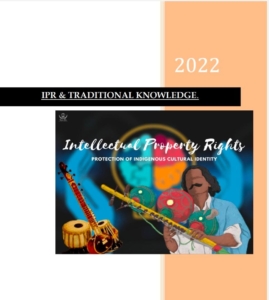IPR & TRADITIONAL KNOWLEDGE ASPECT
Intellectual Property Management Industry Alerts (Volume VIII)
Traditional knowledge aspect of any community is proudly held as recognition of ‘uniqueness’.As the threshold of IPR is based on the principles of novelty and unmatched characteristics, it is essential to protect traditional knowledge from possible attacks of infringement which may lead to wrongful commercial exploitation.
Definition of Traditional Knowledge (TK)-
It is a living body of knowledge that is developed, sustained and passed on from generation to generation within a community, often forming part of its cultural or spiritual identity. As such, it is not easily protected by the current intellectual property system, which typically grants protection for a limited period to inventions and original works by named individuals or companies. Its living nature also means that “traditional†knowledge & is not easy to definei.
Hence, the very basic question arises as to why TK should be protected?
TK can be regarded as the mark of sustainable development of certain indigenous communities.Encroachment by any external social, environmental, migration or modern lifestyles may weaken the traditional means of maintaining or passing knowledge on to future generations. Also, any wrongful infringement may result in the considerable loss in respect & appreciation of the TK. Thus, it becomes the primary responsibility of the ‘Law’ to take in charge of preservation & protection of TK!
So, how should TK be protected?
TK has to be afforded protection by both, developing and developed countries. Such can prima facie be established by granting recognition to the rights of the original TK holders. Introduction of laws (sui generis law can be a great help!) that boldly states about infringement of TK & its possible penalty, is essential. Also, compliance with various international treaties for the preservation of TK can enhance in the spirit of protection of TK right holders. And lastly, economic aspects of such processes should be well known among the TK right holders as such would ensure affordability & accessibility.
There are generally 2 types of Intellectual property protection being sought, firstly is the ‘Defensive Protection’ which aims to stop people outside the community from acquiring intellectual property rights over traditional knowledge and secondly, is the ‘Positive Protection’ which is the granting of rights that empower communities to promote their traditional knowledge, control its uses and benefit from its commercial exploitation.
The Turmeric Patent case-
This is that one landmark case in the history of IPR that has enhanced all the TK holders’ faith in the protection of their rights. The facts of the case were such, in 1995 two Indian scientists working in the U.S. were granted a patent for a method of: “promoting healing of a wound by administering Turmeric to a patient afflicted with the wound.†The patent was assigned to the University of Mississippi Medical Centerii. Later, CSIR from India claimed that the patent lacked novelty as the use of Turmeric as a method for healing wounds was age old in India and therefore a part of the prior art. After considering the claim in 1998, the court ordered the re-examination certificate which signified the end of the case.
Effect of the case-
In an effort to make all the TK subsisting in India & more recognizable, the CSIR, in collaboration with the Department of A created a Traditional Knowledge Digital Library (TKDL). A Task Force was set up for this purpose, and it evolved a meth classification known as the ‘Traditional Knowledge Resource Classification’ (TKRC), using which the TKDL success converted and structured ancient texts into 34 million pages. These have further been translated into English, F German, Japanese and Spanishiii. In fact, according to WIPO, India is the only country in the world to have set up an institutional mechanism – the TKDL – to protect its TK. The TKDL enables prompt and almost cost-free cancellation or withdrawal of patent applications relating to India’s TKiv. To prevent misappropriation of Yoga, Ministry of AYUSH through Sangeet Natak Akademi (the nodal organization of Ministry of Culture) has filed nomination of Yoga at UNESCO to include Yoga in the representative list of the Intangible Cultural Heritage of Humanityv .
Hence, India has left no stone unturned to promote, preserve & protect its TK. In fact, The Protection of Traditional Knowledge Bill’2016 which has been drafted by none other than Dr.Shashi Tharoor validates the above mentioned statement.
This publication is provided for general information and does not constitute  any legal opinion.This publication is protected by copyright. © 2022 Astrea Legal Associates LLP
 Â
Contributed by : Ms. Sonya MohanÂ





